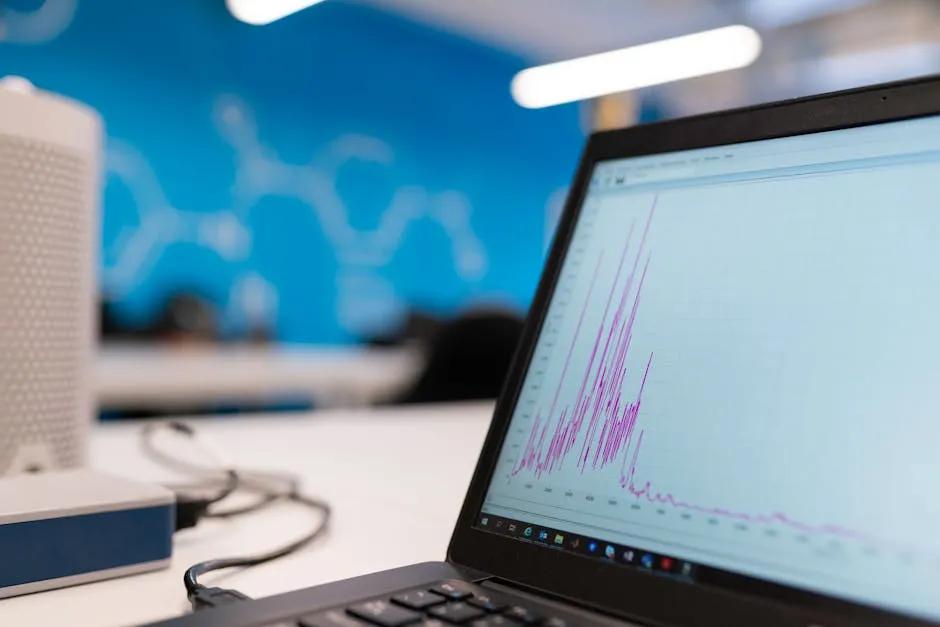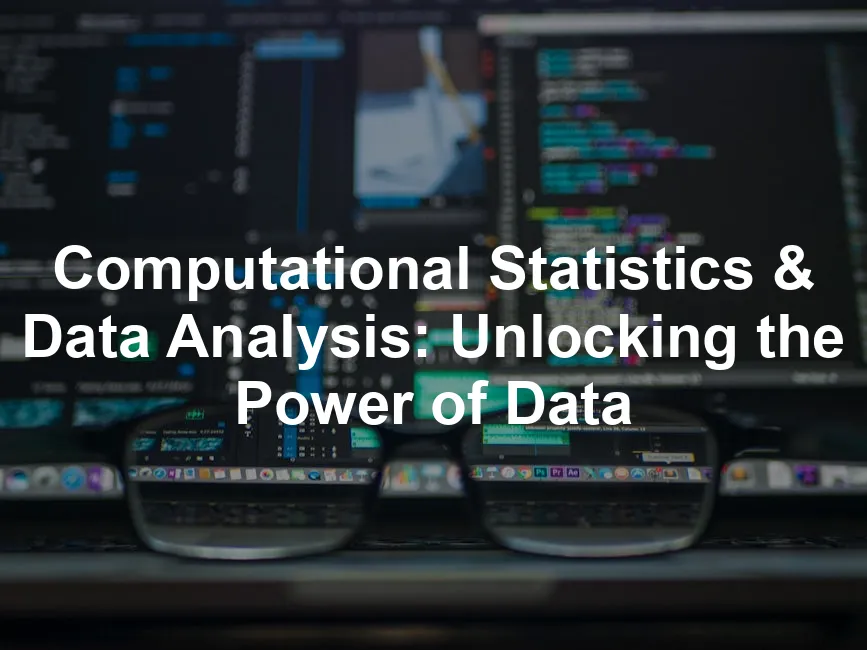Introduction
Imagine you’re a detective on a never-ending case. Your mission? Sift through mountains of data to uncover hidden truths. Welcome to the exhilarating world of computational statistics and data analysis! This field is the Sherlock Holmes of our data-driven society, transforming raw numbers into insightful narratives across various domains. In the realms of economics, healthcare, and social sciences, data is more than just digits; it’s a treasure trove of information waiting to be unlocked. As we navigate through this digital age, the integration of computing with statistical methods has changed the game entirely. Gone are the days when analysts would squint at spreadsheets and agonize over calculations. Now, with sophisticated algorithms and powerful software, we can tackle data like never before. Computational statistics marries the art of statistics with the science of computing. It uses algorithms and computational techniques to analyze complex datasets. This marriage has proven invaluable in decision-making processes across multiple fields. From predicting economic trends to diagnosing diseases, computational statistics is a driving force behind innovation and efficiency. If you’re curious about diving deeper into the world of computational statistics, consider picking up R Programming for Data Science by Hadley Wickham. This gem is perfect for anyone looking to build a solid foundation in R while mastering data science techniques. The significance of computational statistics cannot be overstated. It allows researchers to handle vast amounts of data effortlessly. For instance, in healthcare, it helps in analyzing clinical trial results, improving patient outcomes through informed decisions. In economics, it assists in modeling financial markets, predicting shifts that could impact the global economy. Social scientists use it to understand patterns in human behavior, unveiling insights that were once obscured.
As we continue to generate and collect data at an unprecedented rate, the demand for skilled professionals in this field grows. The ability to interpret data accurately and meaningfully is becoming a crucial skill in today’s job market. Whether you’re a seasoned statistician or a curious newcomer, computational statistics offers a world of possibilities. So grab your magnifying glass, and let’s investigate the nuances of this fascinating field together!Computational statistics is essential for effective data analysis in various fields. tips for effective data analysis in economics and statistics
Summary
In summary, computational statistics and data analysis are pivotal in today’s data-centric world. This article will unravel the intricacies of this dynamic field, showcasing its importance across various sectors. We’ll define computational statistics, explore its interdisciplinary nature, and highlight its relevance in modern research. Readers will discover how computational statistics connects with data analysis, revealing the methodologies that drive impactful results. We’ll dive into applications like machine learning, which empowers businesses and researchers to make predictions and automate processes. Bayesian methods will also be featured, known for their ability to incorporate prior knowledge into statistical modeling. Real-world scenarios will be sprinkled throughout the discussion, demonstrating how computational statistics has revolutionized industries. For instance, we’ll look at healthcare advancements through data analysis, business insights driven by marketing strategies, and environmental assessments that aid in combating climate change.
What is Computational Statistics and Data Analysis?
Definition and Scope
Computational statistics and data analysis form a vital part of the statistical landscape. But what exactly do these terms mean? At its core, computational statistics involves the use of computational techniques to perform statistical analysis. This includes simulations, numerical methods, and the development of statistical algorithms. Data analysis, on the other hand, focuses on interpreting and extracting meaningful insights from data. Together, they create a powerful toolkit for researchers across disciplines. The beauty of computational statistics lies in its interdisciplinary nature. It doesn’t operate in a vacuum; rather, it incorporates elements from computer science, mathematics, and traditional statistics. This blend is what allows practitioners to develop innovative solutions to complex problems. For example, machine learning algorithms—rooted in statistics and computer science—enable predictions based on analyzed data. In practical terms, computational statistics is used to analyze datasets that are too large or complicated for traditional statistical methods. Think of it as the Swiss Army knife of the data world: versatile and essential for modern analysis. As we continue to generate data at an exponential rate, the tools and techniques within computational statistics become indispensable.
Importance in Today’s Data-Driven World
In a world overflowing with data, computational statistics is the superhero we didn’t know we needed. With the exponential growth of datasets—think of it like trying to find a needle in a haystack while the haystack keeps growing—computational statistics swoops in to save the day. This field equips us with the necessary tools to handle vast amounts of data, ensuring we don’t drown in numbers. By utilizing algorithms and computational techniques, we can analyze complex datasets efficiently, making sense of the chaos. Consider this: organizations generate terabytes of data daily. Without computational statistics, we’d be stuck sifting through spreadsheets like it’s 1999. Instead, we can leverage powerful statistical methods to extract meaningful insights. This is crucial in sectors like finance, where quick, data-driven decisions can mean the difference between profit and loss. With computational tools, analysts can model financial trends, assess risks, and even predict future market movements.
In summary, computational statistics is the backbone of effective decision-making in our data-driven landscape. From financial forecasting to healthcare advancements, its role is undeniably significant. As we continue to generate massive volumes of data, the relevance of computational statistics will only increase, paving the way for smarter, more informed decisions.The role of computational statistics is crucial in various sectors, including finance and healthcare. journal of computational statistics and data analysis
Applications of Computational Statistics
Healthcare and Biostatistics
Computational statistics plays a pivotal role in healthcare and biostatistics, especially in clinical trials and epidemiological studies. Imagine a world where drugs are developed faster and diseases are diagnosed more accurately. This isn’t just a pipe dream; it’s happening right now! By leveraging statistical models and computational techniques, researchers analyze patient data to identify effective treatments and improve health outcomes.
Business and Marketing
In the cutthroat world of business, data analysis is like having a secret weapon. Companies leverage computational statistics to gain customer insights and refine marketing strategies. It’s all about understanding what makes consumers tick. With data-driven decisions, businesses can target their audience more effectively and boost their bottom line. Take Netflix, for example. They analyze viewer data to make decisions about which shows to produce. By understanding viewing habits, they’ve created hit series that keep subscribers coming back for more. Similarly, Amazon uses data analysis to recommend products tailored to individual preferences. This personalized experience not only enhances customer satisfaction but also drives sales.
Environmental Science
The environment is a hot topic, and computational statistics plays a crucial role in environmental modeling and analysis. With climate change looming, data analysis provides insights that can inform policy decisions and conservation efforts. By leveraging computational methods, researchers tackle complex environmental issues, from predicting weather patterns to managing natural resources.
Tools and Software for Computational Statistics
Overview of Popular Software Packages
When it comes to computational statistics, the right tools can make all the difference. Several popular software packages have emerged as favorites among data analysts and statisticians. Let’s take a closer look at a few of these heavyweights. R is a powerhouse in the statistical computing world. Its extensive package ecosystem allows users to handle everything from basic data analysis to complex modeling. Plus, its user community is vibrant, offering countless resources for newcomers and seasoned pros alike. Python is another favorite, particularly for those venturing into machine learning. With libraries like Pandas, NumPy, and SciPy, Python makes data manipulation and analysis straightforward. Its versatility extends beyond statistics, making it a go-to language for developers and data enthusiasts.

Challenges and Future Directions
Current Challenges in Computational Statistics
Computational statistics faces several significant challenges, particularly concerning data privacy and algorithmic bias. In an age where data is king, safeguarding individual privacy is paramount. Analysts must navigate complex regulations, such as GDPR, to ensure compliance while still extracting meaningful insights. Balancing these needs is no easy feat. Imagine trying to cook a gourmet meal with half your ingredients missing—frustrating, right? Algorithmic bias is another pressing issue. When algorithms are trained on skewed data, the results can perpetuate existing prejudices. This leads to unfair treatment in critical areas like hiring, lending, and law enforcement. For instance, biased algorithms may unfairly flag certain groups as high-risk, creating a ripple effect of discrimination. Addressing this bias requires a multifaceted approach, ensuring that data is representative and algorithms are continuously audited for fairness.
Future Trends
Looking ahead, several trends are shaping the future of computational statistics. One of the most exciting is the integration of artificial intelligence (AI) with statistical methods. AI is revolutionizing how we analyze data, enabling more sophisticated modeling techniques and predictive analytics. Imagine a world where machines not only crunch numbers but also learn from data patterns, providing insights that were previously unimaginable.
FAQs
What is the difference between computational statistics and traditional statistics?
The distinction between computational statistics and traditional statistics is like comparing a Swiss Army knife to a simple ruler. Traditional statistics relies on formulas and theoretical approaches to analyze data, often working with smaller datasets. It’s like drawing a straight line with a ruler—straightforward, but limited in scope. On the other hand, computational statistics embraces the power of computing. It employs algorithms and simulations, allowing for the analysis of vast and complex datasets. Imagine trying to untangle a massive ball of yarn; computational statistics provides the tools needed to unravel it efficiently. It’s not just about crunching numbers; it’s about leveraging technology to derive insights from data that traditional methods might miss.
How can I get started in computational statistics?
Embarking on a journey into computational statistics doesn’t require a magic wand, just a bit of curiosity and the right resources. Start with online courses on platforms like Coursera or edX. Look for introductory courses that focus on statistics and programming languages like R or Python. These languages are the bread and butter of computational statistics. Books can also be your best friends. Consider titles like ‘The Elements of Statistical Learning’ or ‘An Introduction to Statistical Learning.’ They offer both theory and practical examples. And don’t forget about forums! Websites such as Stack Overflow and Cross Validated are treasure troves of information and community support. Dive into projects that interest you. Analyze datasets from Kaggle or data.gov to apply what you learn in a practical context.
What are some real-world examples of computational statistics?
Computational statistics is like the secret sauce in various fields, enhancing decision-making and analysis. In healthcare, it’s applied in clinical trials to determine the effectiveness of new drugs. For instance, researchers use computational methods to analyze patient data, identifying which treatments yield the best outcomes. In finance, computational statistics aids in predicting market trends. Algorithms process vast amounts of trading data to forecast stock movements. Picture Wall Street analysts armed with powerful tools, making data-driven decisions that could make or break fortune. Environmental scientists also utilize computational statistics. They model climate change scenarios, predicting impacts on ecosystems. Analyzing environmental data helps shape policies aimed at protecting our planet. These examples illustrate how computational statistics fuels innovation across diverse sectors.
Is computational statistics only for researchers and data scientists?
Contrary to popular belief, computational statistics isn’t confined to researchers and data scientists. It’s like a versatile tool that finds applications in various career paths. Business analysts use data analysis to inform marketing strategies and understand customer behavior. In healthcare, professionals leverage these skills to improve patient care and outcomes. Academics utilize computational statistics in research across disciplines. Even educators employ it to evaluate student performance and improve teaching methods. The beauty of computational statistics lies in its adaptability. Anyone who works with data—be it in business, healthcare, or academia—can benefit from its principles and techniques.
What are the ethical considerations in data analysis?
Ethics in data analysis is crucial, especially in today’s data-driven landscape. Privacy concerns are at the forefront. Analysts must ensure they handle data responsibly, protecting individuals’ information. This means adhering to regulations like GDPR, which safeguard personal data. Bias is another significant challenge. Algorithms can inadvertently perpetuate existing prejudices, leading to unfair outcomes. It’s essential to evaluate data sources and model assumptions critically. Transparency in methods and results is vital, fostering trust in the findings. Ultimately, ethical considerations in data analysis shape the integrity and applicability of the insights derived. They ensure that data serves to empower rather than harm individuals and communities.
All images from Pexels




